Struggle with natto’s smell and sticky texture? You’re not alone. But with one secret ingredient and this simple natto recipe for beginners, you can finally enjoy Japan’s famous superfood. Isn’t it worth giving natto a second chance? I promise, it really works.
Love Japanese recipes with bold flavor? Try my Tuna Mayo Onigiri or Easy Tamagoyaki with Fillings.
Jump to Recipe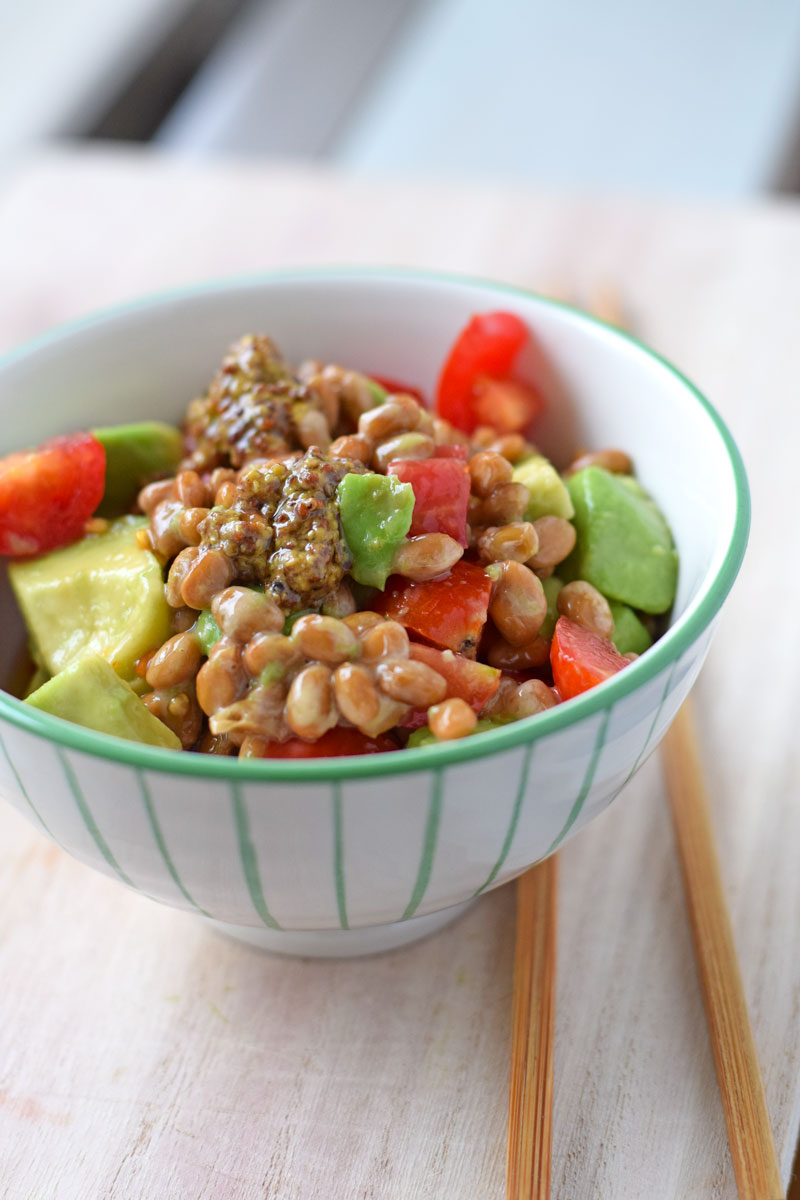
Jump to:
- How I learned to love natto
- Recipe at a Glance
- Health Benefits of Natto: Why This Fermented Soybean is a Japanese Superfood
- How People Learned to Love Natto: Tips for Beginners
- How to Eat Natto: Tips to Enjoy Without the Sticky Mess
- Where to Buy Natto: Online and In Stores
- Frequently Asked Questions
- Easy Natto Recipe (Fermented Soybeans for Beginners)
How I learned to love natto
Maybe you tried natto once and swore never again.
The smell, the texture, the way it clings to your chopsticks—I get it.
I almost gagged the first time too.
But maybe natto just needs the right introduction.
With a few simple ingredients (and one secret one), it’s surprisingly easy to make natto something you’ll actually want to eat. I’ll show you how.
Need help? DM me on Instagram or drop a question in the comments.
❤️ & 🫘 from Japan, Matt
Recipe at a Glance
Cuisine: Japanese
Course: Breakfast · Lunch · Dinner
Diet: Low Carb · Keto-Friendly · Vegan · Vegetarian
Skill Level: Easy
Prep Time: 4 minutes
Servings: 2

Health Benefits of Natto: Why This Fermented Soybean is a Japanese Superfood
In Japan, natto has long been recognized as a traditional superfood. Studies published in reputable medical journals have linked regular consumption of natto and other fermented soy products to improved blood flow and a lower risk of stroke.
Here are some of the top reasons natto is considered so good for you:
- A great source of plant-based protein, making it especially beneficial for vegetarians and vegans
Learn more at Healthline » - High in dietary fiber and packed with essential vitamins and minerals such as iron, magnesium, calcium, and potassium
Verywell Fit overview » - The richest known food source of vitamin K2, which plays a key role in calcium metabolism and supports bone health
See article on WebMD » - Contains nattokinase, an enzyme that has been studied for its potential to support heart health and reduce the risk of blood clots
Read NIH research summary » - Provides beneficial probiotics that can help improve digestion and promote a healthy gut microbiome
Fermented foods overview by Revolution Fermentation » - May help lower blood pressure and improve cholesterol levels, contributing to overall cardiovascular health
(NIH study on nattokinase from natto) »

How People Learned to Love Natto: Tips for Beginners
This week, I surveyed over 100 people in Tokyo and Sapporo and asked one simple question: How did you learn to eat natto?
They shared real-life advice on how they went from gagging at the smell to genuinely enjoying this slimy, sticky Japanese superfood made from fermented soybeans.
Here’s what they said helped the most.
1. Mindset is everything
Many people agreed: your attitude going in makes or breaks your first few tries with natto.
“Just try it as a new challenge. It’s healthy, and you can eat it in many ways.”
“I think half the battle is mental. I had to convince myself it was good.”
“It’s the initial experience that throws you off, but if you muster enough courage to try a second time, it’s actually fine.”
“Used to hate it, but heard it’s great for your body, so I forced myself to eat it. Now I love it.”
“It helped that someone told me it’s an acquired taste, like aged cheese. I love cheese! But if you try it thinking it’s gross and snotty, your brain already expects to hate it.”
2. Start small
You don’t need to eat a full pack on day one. Several people recommended easing in gradually.
“At first I ate tiny amounts mixed into my rice.”
“When my husband had natto, I’d steal 4 or 5 beans off his plate. Eventually, I worked my way up to a full serving.”
3. Toppings that help mask the flavor
Toppings can completely change your natto experience. They help mellow the flavor, tone down the sliminess, and mask the smell.
“I like it hot, on freshly steamed rice with raw egg and karashi mustard.”
“I eat it at least three times a week with raw egg and a dash of soy sauce.”
“One day I added parmesan cheese on rice. It worked. Kimchi too. That’s when I stopped disliking it.”
“Natto curry. That’s how I learned to like it.”
“In the beginning, I had to mix it with kimchi, mayo, or Korean seaweed. Now I’ll even eat it with avocado and soy sauce. Ume-shiso is amazing. Try going full neba-neba and add grated yamaimo, okra, mekabu.”
“Use ponzu instead of soy sauce. Somehow it reduces the slimy feeling.”
“The recipe that changed me was a natto cheese omelet.”
“I used to hate it. But then I mixed it with kimchi, rice, and melted cheese. It basically masked the natto completely.”
“My favorite mix is avocado, green onions, and ponzu.”
My personal trick: extra-virgin olive oil
Olive oil coats the beans. It covers up the taste and smell and reduces the sliminess.
You’ll find my full illustrated natto recipe below.
Let me know which tip worked for you. You might just become a natto lover too.
Looking for more tasty ways to enjoy natto? Try my low carb okra recipe with natto. It’s simple, oh-so cheesy, and perfect as an izakaya side dish or breakfast.

How to Eat Natto: Tips to Enjoy Without the Sticky Mess
How People in Japan Eat Natto
In Japan, the most basic way to eat natto is to mix it with the included tare (soy sauce–based sauce) and karashi (spicy mustard), then eat it straight from the pack over hot rice.
However, many people don’t stop there. Natto is often customized with flavorful toppings or served as part of a meal.
Popular additions include:
- Chopped green onions
- Katsuobushi (shaved bonito flakes)
- Kizami nori (shredded seaweed)
- Raw egg (tamago kake gohan style)
- Kimchi
- Grated yamaimo, okra, or mekabu for a full neba-neba (slimy) experience
You’ll even find creative natto dishes at restaurants, such as:
- Natto pasta
- Natto-stuffed atsuage (fried tofu)
- Natto tempura
One of my favorite budget meals in Yoyogi Uehara was natto-kimchi served with yakitori. It cost just 200 yen and was surprisingly addictive.
Note: If you're outside Japan, skip the raw egg unless it's pasteurized or from a trusted source. A sunny-side-up egg makes a great substitute.
How to Open Natto Without Getting Sticky Strings Everywhere
- Open the pack and remove the small packets of tare and karashi.
- Peel off the clear plastic film that covers the natto. The sticky strings will cling to it.
- Twirl the plastic sheet in the air like a ribbon dancer. This might sound silly, but it helps fling off the sticky threads.
Some people recommend mixing the natto before adding the sauce to enhance the umami and make it even stickier (in a good way). Others add the tare and mustard first. Either way works!
How to Eat Natto with Chopsticks (Without Making a Mess)
Natto’s signature strings can make things messy, especially if you’re eating it straight from the pack.
Here’s how to keep it under control:
- Hold your bowl close to your mouth in one hand.
- Pick up the natto with chopsticks, keeping them horizontal, and lift vertically above your bowl.
- Gently bounce your chopsticks up and down to let loose beans fall back in.
- As you bring the chopsticks to your mouth, make a few slow counterclockwise circles in the air to break any lingering strings.
My guess is that most Japanese people do this instinctively, without realizing it.

Where to Buy Natto: Online and In Stores
If you’re in Japan, you’d have a harder time not finding it. Natto is everywhere. Even your local 7-Eleven stocks it in the refrigerated section.
For higher-quality options, check supermarkets like Kinokuniya, Seijo Ishii, Tokyu, or Queen’s Isetan. These usually carry a good selection, including organic and specialty kinds.
If you’re outside Japan, finding natto takes a little more effort. Here are some popular places to buy natto online or in stores near you:
- United States
Many Japanese and Asian grocery stores carry frozen natto. You can also order directly from specialty natto producers. For example, Megumi Natto is a California-based farm that makes and ships organic natto. - Australia
BuyAsianFood.com.au offers frozen natto for home delivery. - Singapore
Isetan’s Japanese grocery section carries my favorite organic natto. - Europe
Nanuko.de sells Japanese groceries including natto.
NikanKitchen offers several brands online.
Japan Centre (UK) ships across the UK and sometimes Europe.
Since natto is often shipped frozen, check reviews or contact the seller about freshness and packaging.
Still can’t find it? Ask a Japanese friend, neighbor, or someone in your local community. They might know the best nearby spot to get the good stuff.
Or send me a message. I live near Azuma Natto’s headquarters in Japan and would be happy to help you find some natto in your area.
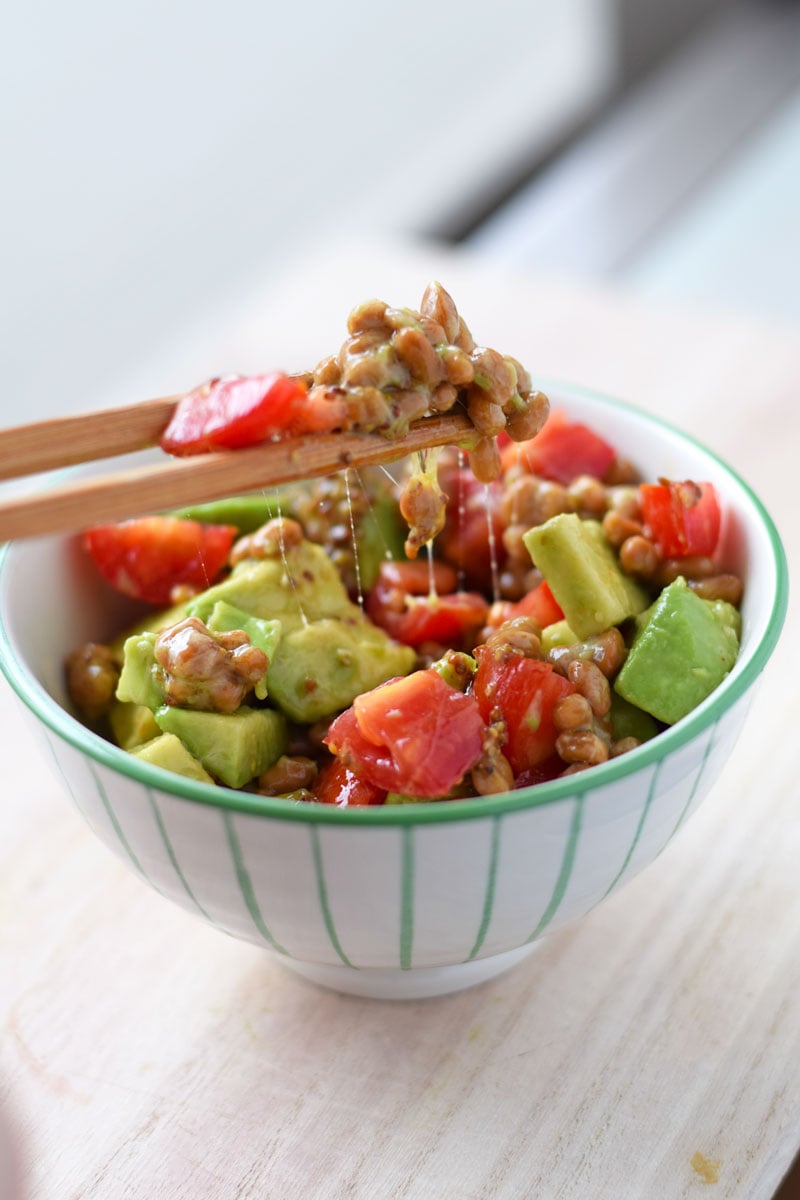
Best Natto Brands
There’s a lot of good natto in Japan.
One of the best natto brands to start with is Azuma. It's my go-to brand during the week. Their natto is affordable and easy to find in most major supermarkets across Japan, which makes it a great everyday option. When I first started eating natto, I preferred their hikiwari variety, which is made with finely chopped soybeans. The smaller pieces made the texture more approachable as I was getting used to it.
These days, I usually buy their Yuki Sodachi variety, which uses organic whole soybeans. I like that it comes in paper cups instead of the usual styrofoam, which feels like a small but meaningful step toward sustainability and cutting down plastic waste.
Azuma’s organic, non-GMO soybeans are grown in the United States. For their non-organic lines, the soybeans are often sourced locally in Japan.
When I lived in Sapporo, I found some amazing Hokkaido-made natto at a small natural foods store. I still haven’t tried black natto, but it’s on my list. I’m always exploring and tasting with the hope of discovering the next best natto in Japan.
If you’ve found a favorite natto brand, especially a local one, I’d love to hear about it in the comments.
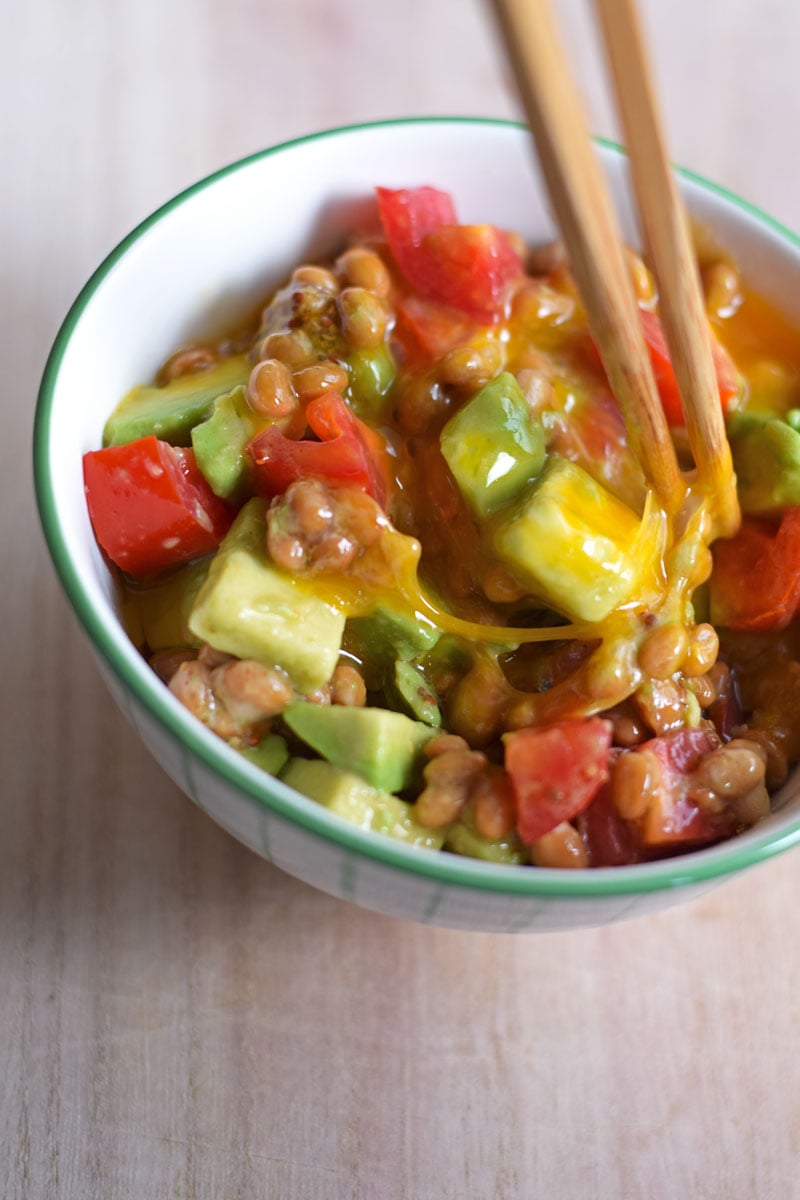
Frequently Asked Questions
Natto is a traditional Japanese food that's made from whole soybeans that have been fermented. Japanese natto is famous for it’s strong smell, slimy texture, and dangling strings of goo.
In Japan, it's eaten on its own, typically with breakfast. It's also used as the main ingredient in the traditional Japanese dish, natto gohan, which simply means natto over white rice.
Natto gohan with miso soup is a go-to breakfast for money-strapped college students. It's cheap, quick and easy to make, yet still packed with nutrition!
You can even buy natto packs at all the convenience stores in Japan. Just like sushi, it’s part of the culture here.
Since natto is such a polarizing food, it really depends who you ask.
People who hate natto might compare it to dirty socks or worse. People who love natto often compare it to aged, stinky cheese with a subtle nutty flavor.
Really, it's hard to say that natto tastes like anything else I've ever eaten. Once you try natto for the first time, you'll know what I mean.
If you aren't able to find packs of natto where you live, it is possible to make your own at home.
My former Australian colleague makes her own natto in her yogurt maker. She brought me some and it was good!
It's also possible to ferment natto in an instant pot. Or you can even buy your own fermented soybean maker machine.
You need is some whole soy beans, a natto starter culture natto bacteria (bacillus subtilis), and time.
Before fermenting, you can cook your whole soy beans in a pressure cooker or steamer.
Here are some blogs that will teach you how to make your own authentic, Japanese natto:
How to Make Natto with a Yogurt Maker
DIY Instant Pot Natto
How to Make Natto in an Instant Pot
Natto is best source of k2 out of any food in the world!
One tablespoon of natto contains 150 micrograms of vitamin K2.
In general, legumes and beans are not keto because of their high net carb content.
Natto is somewhat of an exception to the rule.
Because natto is fermented, the bacteria actually eats away a percentage of the sugars.
According to Ketogenic Info, one-quarter cup of natto contains only 4 net carbohydrates.
From my research, you may be able to incorporate natto into a keto diet without going out of ketosis.
But it's advised that you stick to one portion (40 gram container).
One note: the pack of tare (sauce) that comes inside each pack of natto contains high fructose and/or refined sugar.
Sugar is usually the first or second ingredient listed.
According to Takano Foods, the distinct smell is produced by the natto bacteria.
The main chemical components of the odor are the ammonia smell and other organic acids. These are produced after the natto bacteria decomposes the soybean protein during the fermentation process.
Fermentation progresses little by little as days pass after production, so the smell gradually becomes stronger.
If you have any other questions about my natto recipe or natto in general, just let me know in the comments below.
Ready to learn how to make natto taste good? Here’s my favorite natto recipe and the secret ingredient!
Did you try this recipe? Tag @eyesandhour on Instagram and leave a ⭐️⭐️⭐️⭐️⭐️ rating & comment below!
What’s your favorite way to eat natto ? Let me know in the comments!

Easy Natto Recipe (Fermented Soybeans for Beginners)
Ingredients
- 2 packages natto
- ½ or 1 avocado
- 5-8 cherry tomatoes
Dressing
- 2 tablespoon extra virgin olive oil
- ½ teaspoon balsamic vinegar
- 1 teaspoon French dijon mustard
Optional (Advanced)
- 1 raw egg yolk*
Instructions
- Cut avocado into bite-sized chunks inside it's skin. Set aside.

- On a cutting board, cut cherry tomatoes into halves or bite-sized chunks. Set aside in a bowl.

- Open the packages of natto. Using a spoon, or chopsticks, scoop natto into a bowl.

- With a spoon, scoop avocado out of its shell with a spoon. Add to the bowl.

- Add cherry tomatoes.

- Gently mix ingredients together with chopsticks or a spoon.

Dressing
- In a small bowl, combine the mustard, balsamic vinegar, and extra virgin olive oil.*

- Mix the dressing with a spoon or chopsticks.
- Pour dressing on top of natto, avocado, and cherry tomatoes.

- Optional: remove the whites from a raw egg.

- Add yolk on top.*



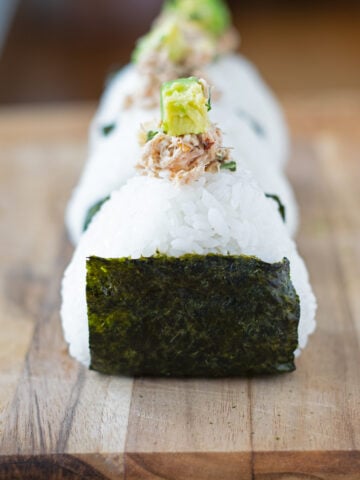

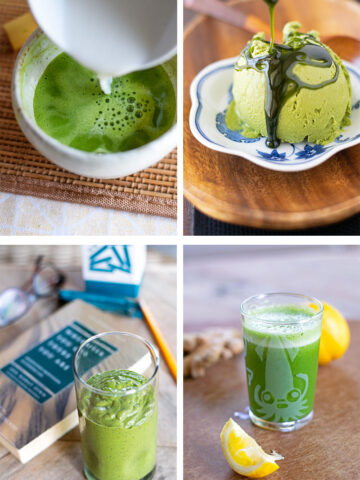


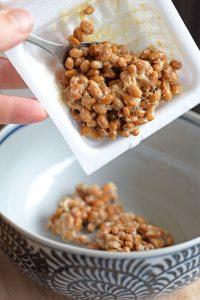
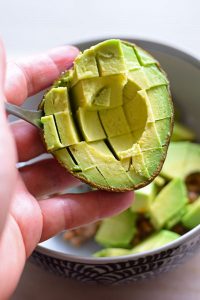




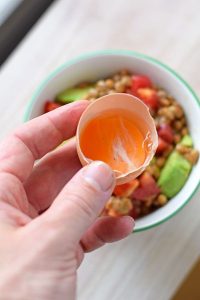

Kate says
what sized portion of natto equals about 50mcg of K2? Does it matter what kind of beans I use. I hate chickpeas. Black beans or red kidney beans ok to use??
Matt says
Hi Kate, One tablespoon of natto contains 150 micrograms of vitamin K2. I would guess other beans might work for this recipe. Thank you for your interest!
Vicki Harford says
I am an elderly woman and recently started to eat Natto for bone health. It is the best source of K2. I don't, but it is good to have Natto every day.
Vitamin K2, although a fat soluble vitamin, is not stored in the body.
I fry up some brown rice, scramble an egg each time. Then I experiment with other ingredients. But the one thing I always do is use ghee to cook the rice and the egg. That beautiful butter flavour really smooths out the taste of Natto.
Matt says
Thank you for your comment, Vicki! That sounds like a good breakfast to me. I’ve never cooked with ghee. I cook with grass-fed butter. I’ve also started to supplement with vitamin D, to go with the K2 in natto. I was deficient. That’s wonderful that you are eating natto! Wishing you good health!
Laverne says
I am a senior woman who eats natto for bone health. I have not learned to like it yet so I eat it partially frozen mixed into Chobani Peach Greek yogurt. I recently learned it is tradition to stir the natto before eating. Is this necessary?
Stirring seems to make a foam and extra stringiness and to my palate makes the flavor and smell stronger. Is there any benefit to stirring before eating?
Matt says
Yes, in Japan pretty much everyone mixes natto before eating. But no, this is not necessary, especially if you don't like the foam. In the Japan, usually the foaming is a learned preference.
The mixing is create the foaming texture to improve the taste. Partially freezing natto may kill off the healthy bacteria. I know heat will kill the bacteria on natto. So you may want to avoid it, if you can acquire the taste! Let me know if you need any help.
Laverne says
Hello Matt. Thank you for this information. I purchase frozen natto at a local Japanese market. The packages sometimes list a lot number but I have not seen any information about expiration date or date of manufacture. The package label is all in Japanese with a label attached in English with the nutritional information. Do you think the expiration date is written in a Japanese character?
Keiko says
I love Natto but I never thought of this recipe!! I will try it soon:)
Matt says
Thank you so much, Keiko san! I hope you loved this recipe! I love natto too. 🙂
Jessica says
Do you have any recipes that would decrease (or hide) the stringyness? Also, could I put it in a blender, blend it up and add it to things? The texture/stringyness are really a challenge for me, but I want to eat it!
Matt says
Hi Jessica, First, I'd highly recommend coating your natto with olive oil like in this recipe. That should help with making it less stringy and it somewhat masks the gooey texture. Also, avoid mixing the natto, which makes it more gooey and stringy. Besides that, if you mix it with something else, like scrambled eggs and cheese, that helps too. The downside is that cooking natto will kill off lots of the healthy live bacteria that's so good for you! Let me know if you need any more help. You'll get there! It took me a week to acquire the taste. Now I love it!
Laverne says
I previously posted a comment suggesting to mix natto into peach yogurt. I have found a BETTER flavor that tones down the unique flavor of natto. Please try mixing partially frozen natto into Chobani Greek Honey yogurt, Stirring it into yogurt also hides the stringiness. Eat it right away before it starts to warm up.
Matt says
Interesting! I've never thought of mixing natto with yogurt!
Mary Lou says
Hi Matt, I have never tried natto, but I have something called Hashimoto's Disease. If you have it, it can lead to other autoimmune diseases. I suspect my body is collecting plaque at the elbows, knees and elsewhere. The last time I saw my doctor, he said my cholesterol and blood sugar were very high. I found someone on Youtube who said one of the best ways to clean arteries and veins was eating natto. I have heard heart disease and related problems were rare in Japan. Is that true? Thank you for your site and the information you share. This is my first visit. Tomorrow I will see if I can buy natto somewhere locally.
Matt says
Hi Mary Lou! I have family members back home in the the US with Hashimoto's Disease so I'm familiar. A big part of why I started this blog is the share what I learned from Japan with the Western world and my family back home. It's true that the rates of lifestyle-related diseases, obesity, diabetes, are much, much lower here in Japan than in the US. Please let me know how I can help you along your journey to health. Natto is an acquired taste. If you have questions or would like recommendations, please let me know. I recommend Dr. Mark Hyman's books and interviews. That's a great place to start.
Some dude says
I could never take a single bite of natto without feeling nauseous and like vomitting but this recipe helped me eat half a packet. Pretty impressive.
Matt says
That's awesome, Jake. It took me a week to acquire the taste. I'd love to hear from you to find out if you eventually learn to love it!
Laverne says
Hello Matt
Thank you for the helpful information posted here. I live in California and purchase frozen natto from a Japanese market called Tokyo Central. I try to eat it daily mixed into yogurt and have done so for over 1 year. I do not use the flavor packets that come with the natto. Unfortunately I have not acquired a liking for it but continue to eat it for the health benefits. Do stores in Japan typically sell non-frozen natto?
Also I watched an interesting documentary about natto on a show called Medical Frontiers on NHK World. The title is "The Power of Natto, a Japanese Superfood." It is available to watch online. It is very informative and helps me to stay motivated to continue eating this fermented product. It also shows some additional recipes.
Matt says
Hi Laverne, thank you for your comment! Yes, I eat natto pretty much every day. I don't think I've ever seen frozen natto in Japan but we eat a lot of it! And thanks for the tip. I'll check out the NHK World episode. I used to do some food writing for the NHK World webpage. I hope you have a wonderful holiday in California! It's getting chilly here in Tokyo.
Ayana M. says
Thanks so much for this recipe; it was very yummy. For my first time trying natto, I used this recipe, but I subbed the tomatoes for baby bell peppers that I blanched and added half a teaspoon of sweet soy sauce.
Matt says
Hi Ayana, Thank you for taking the time to leave a comment and for the 5 star review! I'm happy you loved the recipe, which is amazing for your first time trying natto. Baby bell peppers sounds yum!